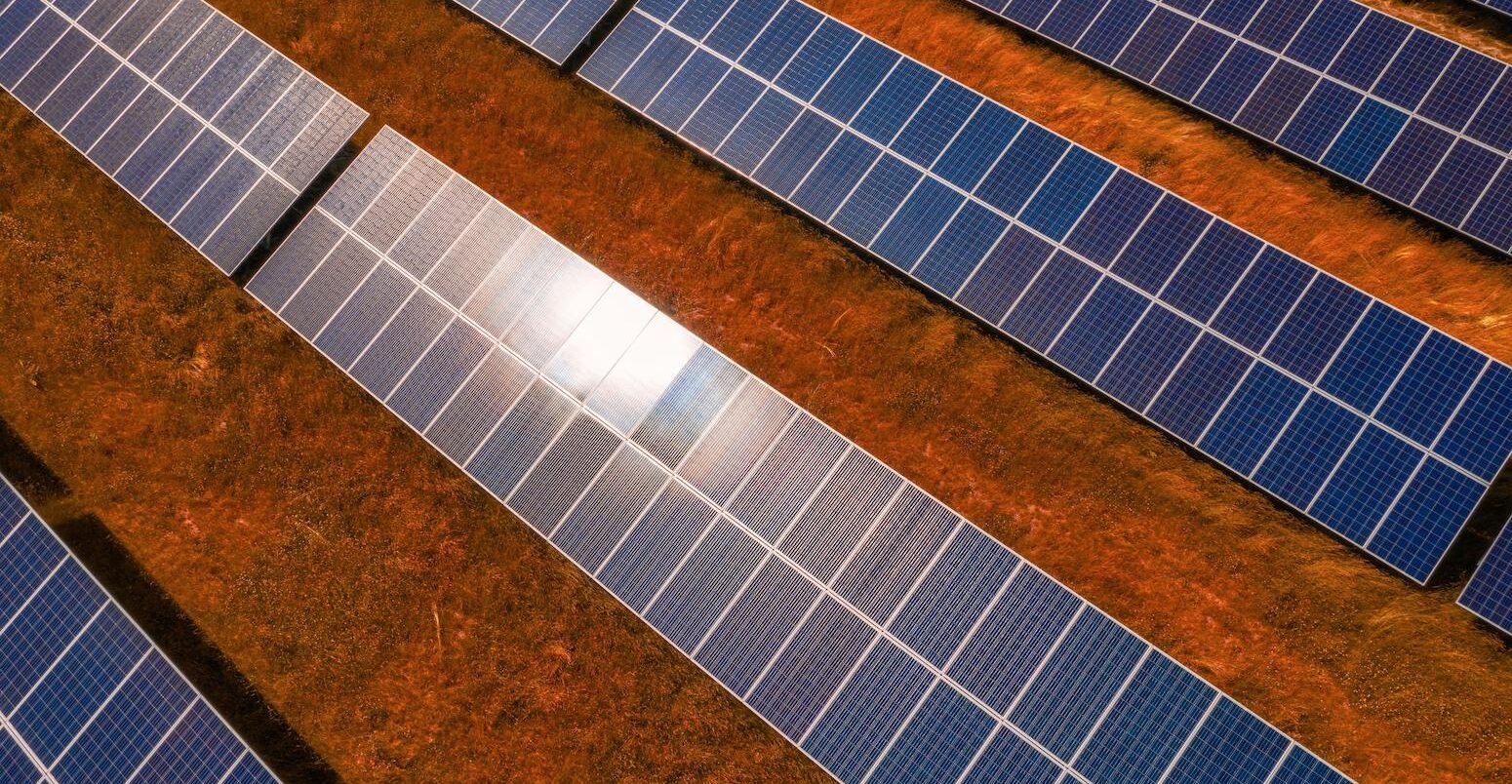
Guest post: How the Inflation Reduction Act narrows the gap to US climate goals
Multiple Authors
08.16.23Multiple Authors
16.08.2023 | 8:00amThe US has an important role to play in limiting climate change as the world’s second-largest emitter and the country with the greatest historical responsibility for current warming.
After re-entering the Paris Agreement, president Joe Biden set targets of cutting greenhouse gas (GHG) emissions to 50-52% below 2005 levels by 2030 and reaching net-zero by around the middle of the century.
Biden’s Inflation Reduction Act (IRA), passed a year ago in August 2022, is seen as the key policy for meeting these goals. The IRA provides an estimated $400bn to incentivise clean energy, support electrification and energy efficiency measures, reduce methane emissions, promote domestic manufacturing and supply chains, and address environmental justice.
But questions remain about whether it puts the US on track.
Our new paper, published recently in Science, uses nine leading models of the US energy system and economy to find out how the IRA might affect the country’s energy use and emissions.
Intercomparison projects of this sort are often used to identify which findings are robust across a range of different models and assumptions – and where results differ.
We find that the IRA brings the US significantly closer to meeting its 2030 climate target, taking expected emissions from 25-31% below 2005 levels down to 33-40% below.
Our analysis provides a range of decision-relevant information, including highlighting the remaining “implementation gap” if the 2030 target is to be met.
Narrowing the implementation gap
Overall, we find robust agreement across the different models that the IRA significantly narrows the implementation gap in delivering the 2030 US target.
Economy-wide reductions in GHG emissions range between 33-40% by 2030 under the IRA, compared to 25-31% without the IRA (i.e. the “reference” scenario).
In the figure below, economy-wide emissions below 2005 levels in the US are shown across the six US energy system models (three of the nine models focus only on the power sector and are therefore not displayed). Historical emissions are in black, followed by projected emissions under the IRA (blue) and under a reference scenario without the IRA (red) through to 2035.
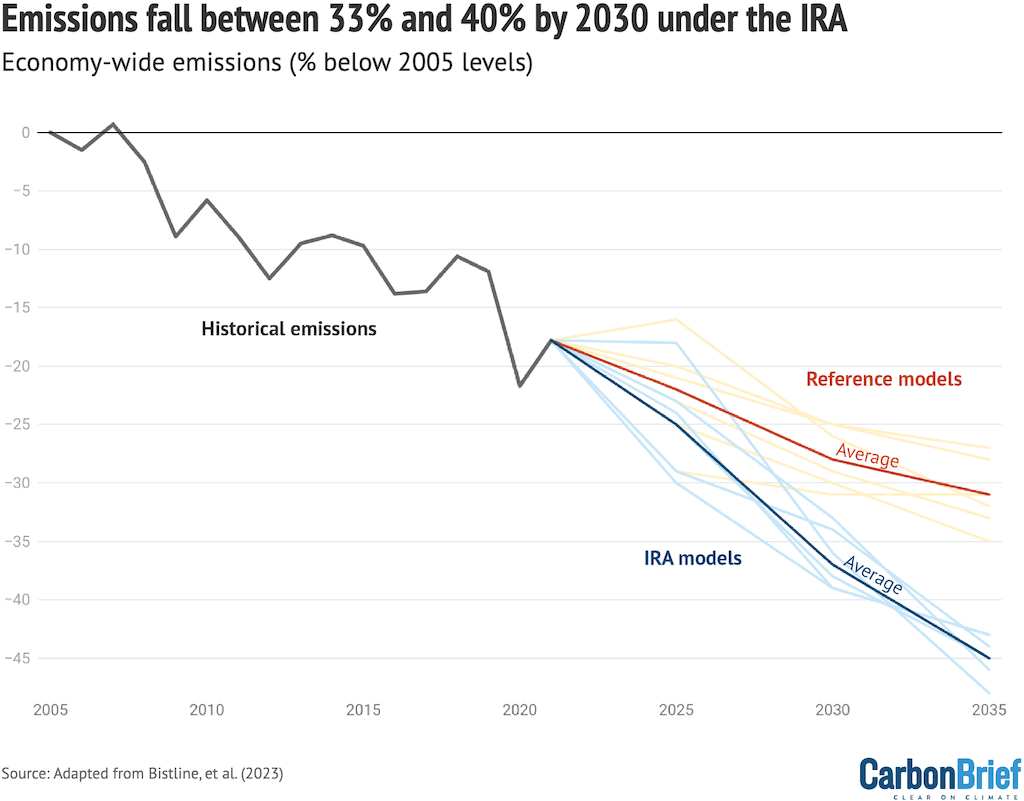
Sectoral breakdown
Though the IRA is expected to drive emissions reductions across all energy sectors, our results show that the extent of these reductions vary.
The figure below shows changes in GHG emissions from the reference scenario across the nine models. Emissions are broken down by sector, with a circle designating the reduction in each modelled year under the IRA that is beyond what would be expected without the act.
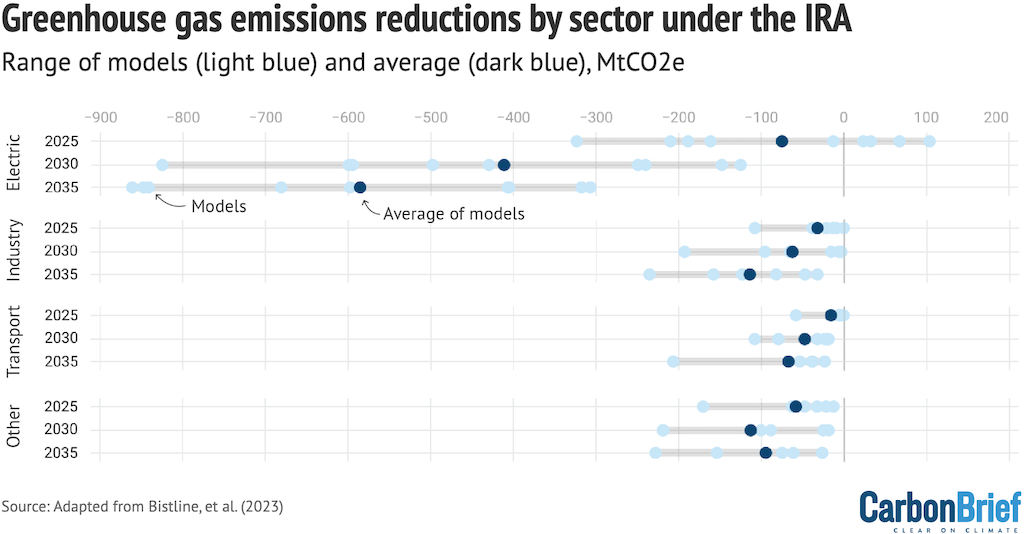
Our models agree that the electricity sector represents the majority of emissions reductions from the IRA, accounting for 38-80% of the total 2030 reductions compared with the reference scenario.
The IRA has many provisions related to electricity, including tax credits for deploying renewables, expanding energy storage and carbon capture, and maintaining nuclear capacity. So it makes sense that emissions reductions would be larger in this sector, especially given its lower mitigation cost opportunities.
The act could bring about large increases in wind and solar deployment, as well as significant declines in unabated coal generation, according to our models. However, the models vary on wind and solar growth rates, which range from 10-99 gigawatts per year (GW/year) from 2021 to 2035.
(The range of cross-model variation in emissions and clean energy deployment is due to differences in trends under the baseline scenario, as well as factors such as model structure – for example, temporal resolution, financing, foresight – and input assumptions, such as technological costs and natural gas prices).
Unabated coal generation is expected to fall by an estimated 38-92% from today’s levels by 2030 under the IRA, which contrasts with 3-60% in the reference scenario.
Gas generation could also decline under the IRA relative to today’s levels, although gas-fired capacity will increase as peak demand grows and coal retires.
These ranges are shown in the figure below along with others for key electricity sector metrics and economy-wide metrics across models for both the IRA scenario (orange) and the reference scenario (blue) are shown.
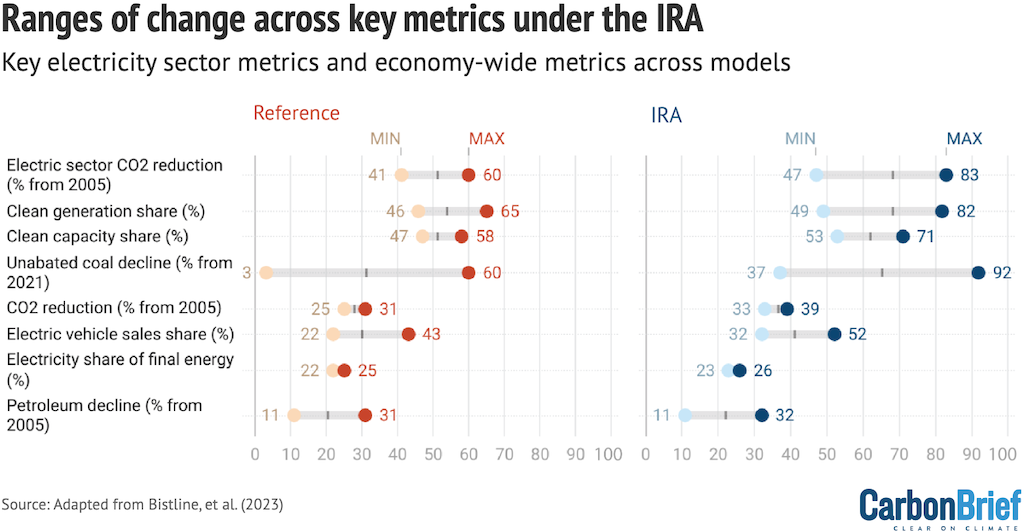
The transportation sector exhibits accelerated electrification under the IRA. The act includes up to $7,500 in tax credits for purchases of “light-duty” electric vehicles (EV) – that is, passenger cars and vans – and up to $40,000 in tax credits for commercial EV purchases. This has the potential to lower upfront costs and could therefore encourage consumers to buy EVs over internal combustion engine vehicles.
Additionally, the IRA’s subsidies for low-carbon resources are expected to reduce electricity prices, in turn lowering the operational costs of EVs and further encouraging adoption.
EV sales reach 32-52% for all light-duty vehicles by 2030 under the IRA, compared to 22-43% in the reference scenario, though this trend flattens out after 2030 as IRA tax credits expire.
Electrification also increases for commercial vehicles, including vans, buses and trucks, under the IRA, our modelling shows. The transportation sector has the highest growth in electrification of all the end-use sectors, with electricity supplying 2-6% of final energy use in the sector by 2030 under the IRA, compared with 1-4% in the reference scenario.
(The higher share of new sales that are EVs will take time to filter through into larger impacts on the overall fleet of vehicles on the road.)
Other IRA incentives encourage building efficiency and electrification, as well as the use of low-carbon fuels in the industrial sector. Overall, transitioning from fossil fuels to electricity in end-use sectors increases the electricity share of final energy from about 21% today to 23-26% by 2030 and 25-29% by 2035, our modelling shows.
(While this increase appears modest, electricity’s share of final energy has remained steady at around 21% since 2010.)
Oil and gas consumption declines under the IRA, due to increasing demand for electricity and the development of new markets in industry and fuels, including carbon capture, hydrogen, biofuels and sustainable aviation fuels.
Tallying the IRA’s benefits and costs
Through its impact on reducing fossil fuel use, the IRA is estimated to deliver significant climate benefits, ranging from $44-220bn annually by 2030 across our models.
The range in this estimate is due to uncertainty around the social cost of carbon dioxide (CO2) – the way in which the potential costs and benefits of CO2 emissions are calculated in monetary terms. The calculation depends on the discount rate used and model-specific emissions impacts of IRA, which would influence associated benefits calculations (both these elements are shown in the figure below).
The figure below illustrates the climate benefits from the IRA in 2030 across all models, comparing a 2% near-term discount rate for CO2 (in green) and a 3% discount rate (in purple).
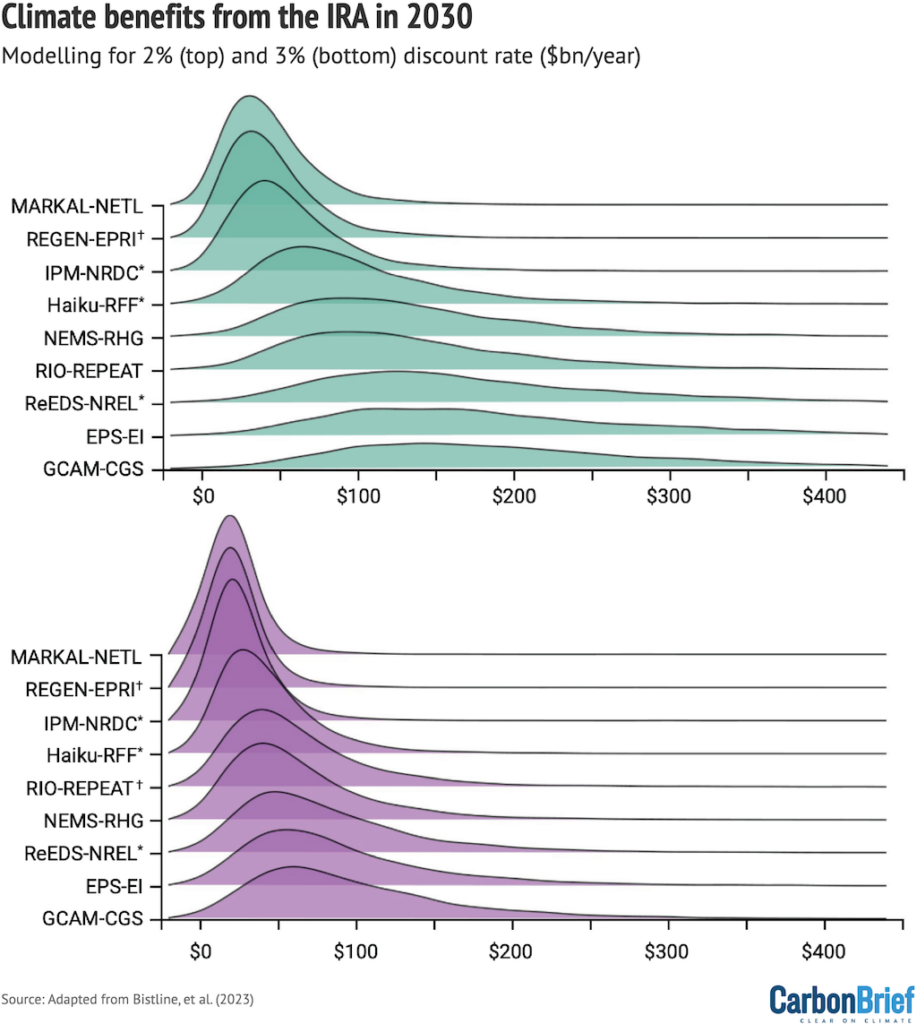
In addition to yielding climate benefits, the reduced use of fossil fuels under the IRA leads to better public health outcomes through lowering emissions from conventional air pollutants, such as sulphur dioxide and nitrogen oxides.
At the same time, the IRA is estimated to lower energy costs for households and businesses, despite increases in electricity spending due to electrification and accelerated investments. Net spending on energy declines by $13-$190 per household annually by 2030.
Limitations and next steps
Our multi-model analysis shows that the IRA helps to accelerate decarbonisation through to 2030 and beyond, lowering costs and amplifying existing trends, though additional action is needed to achieve the US climate target under the Paris Agreement.
Emissions reductions under the IRA may predominantly be felt in the electricity sector through increased clean energy deployment, though the transportation, buildings and industry sectors may also see reductions.
It is important to note that the impact of the IRA will depend on some uncertainties that are difficult to capture in our models, including clean energy adoption, producer choices, household purchases and actions by policymakers.
As an example, lowering clean energy costs could motivate both federal and non-federal actors to enhance their climate actions. Recently-proposed power plant performance standards from the US Environmental Protection Agency (EPA) are based on technologies where the IRA provides significant tax credits, including carbon capture and storage and hydrogen.
IRA tax credits can also lower learning curves and encourage further deployment by making low-carbon technologies cheap, though there is larger uncertainty around how this may occur for emerging technologies.
(Recent analysis from consultancy the Rhodium Group suggests this technology and innovation “spillover” effect could generate even larger emissions savings outside the US, with 2.4-2.9 tonnes of CO2 reductions overseas for every tonne saved domestically.)
While our analysis helps clarify our understanding of the IRA’s impacts, there is still much to learn – and our work so far offers a solid foundation for future research. An important next step could be to compare these models at the sectoral level to provide more detail on how the IRA affects individual sectors.
Furthermore, as the IRA alone will not achieve the 2030 target, the additional federal and non-federal actions that would be needed to get on track could be evaluated.
This includes policies such as the proposed amendments to fossil fuel-fired power plant emissions standards, the proposed federal fuel economy standards, renewable portfolio standards, EV sales targets and so on.
Bistline, J. et al. (2023) Emissions and energy impacts of the Inflation Reduction Act, Science, DOI:10.1126/science.adg3781
-
Guest post: How the Inflation Reduction Act narrows the gap to US climate goals





